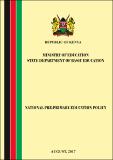| dc.date.accessioned | 2024-07-17T06:57:54Z | |
| dc.date.available | 2024-07-17T06:57:54Z | |
| dc.date.issued | 2023 | |
| dc.identifier.uri | https://repository.kippra.or.ke/handle/123456789/4906 | |
| dc.description.abstract | Maternal and child health (MCH) is a global priority, yet child stunting remains a significant concern particularly in arid and semi-arid regions of Kenya. This study investigated the socio-demographic factors influencing child stunting, examining child-specific attributes, household features, and community factors. The study was informed by the Theory of Human Capital Expenditure and Household Production Framework. The main data source was the Kenya Demographic and Health Survey 2022 (KDHS 2022). The study adopted the Ordinary Least Squares and the binary choice model. The analysis revealed associations between socio-demographic factors and child stunting. Longer breast feeding duration exhibited a significant positive correlation with stunting, while higher birth weight demonstrated a positive effect on reducing the likelihood of stunting. Younger maternal age and higher numbers of children under 5 years in households showed an increased likelihood of stunting. Notably, education and antenatal visits had a positive impact on reducing the prevalence of stunting. However, sanitation and water improvements showed inconsistent and insignificant effects on stunting across models. To address child stunting, it is important to encourage longer breast feeding periods for healthy child growth. Initiatives focused on maternal health during pregnancy may lead to increased birth weights and subsequently reduce stunting. The strategies targeting younger mothers and households with multiple young children are crucial. Improving maternal education and healthcare services, especially in high-stunting regions, could be beneficial in improving the health of children. While findings regarding water and sanitation were inconclusive, integrated programmes promoting proper sanitation habits and safe water access are suggested. This study underscores the multifaceted nature of child stunting in arid and semi-arid lands (ASALs) and proposes targeted interventions to mitigate its prevalence. Understanding socio-demographic factors influencing stunting is critical in formulating effective policies and interventions to improve child health outcomes in these vulnerable regions. | en |
| dc.language.iso | en | en |
| dc.publisher | The Kenya Institute for Public Policy Research and Analysis (KIPPRA) | en |
| dc.relation.ispartofseries | DP/319/2023 | |
| dc.subject | Maternal Health | en |
| dc.subject | Child Health | en |
| dc.subject | Child Stunting | en |
| dc.subject | Socio-demographic Factors | en |
| dc.subject | Child-specific Attributes | en |
| dc.title | Discussion Paper No. 319 of 2023 on Socio-Demographic Effects of Child Stunting in Arid and Semi-Arid Regions of Kenya | en |
| dc.type | KIPPRA Publications | en |
| ppr.contributor.author | Mang'eni, Elizabeth | en |
| ppr.contributor.author | Maitai, Jedidiah Muriithi | en |




